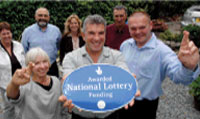» Behaviour

Self Injurious Behaviour
 What is the nature of self-injurious behaviour in CdLS?
What is the nature of self-injurious behaviour in CdLS?
Self injurious behaviour occurs in about 60% of children and adults who have CdLS at a level which causes tissue damage (bruising or bleeding) at least once in a month.
Severity and frequency vary significantly between people, from an occasional scratch, bang or bump to frequent self-injury, resulting in open wounds in a small minority.
The most important things to know about self-injury in CdLS are that it is not inevitable and that it can be prevented and reduced with the right kinds of assessments and interventions.
It is worth noting that whilst self-injury is common in CdLS it is no more common than we would expect by chance.
If we compare the prevalence of self-injury in CdLS with that seen in people who are matched for degree of disability and mobility, age and sex, then there is very little difference.
What does differ between these groups are the more mild forms of self-injury (very mild skin picking and the occasional bump of the head for example) which we see much more commonly in CdLS than a matched group.
The other difference is that in CdLS the self-injury is much more likely to take the form of biting and to be directed towards the handslower arms.
Self-injury has a significant impact on quality of life for everyone concerned and deserves the attention of researchers and clinicians alike. Here we outline the causes and treatments for self-injury in CdLS.
What are the causes of self-injurious behaviour in CdLS?
There are three main causes of self-injurious behaviour in CdLS and there are other factors that can make things worse when any of these causes is responsible.
The most important thing to do is to keep an open mind about the possible causes of self-injury and then to systematically work through assessments to address each cause.
1. Pain and discomfort
The research of Angelo Selicorni and his colleagues in Milan has confirmed the clinical observation of many professionals that gastro-oesophageal reflux is associated with self-injury.
The evidence for this is mounting with the Milan group showing that self-injury decreases when reflux is treated and we have recently found that self-injury is significantly associated with reflux related behaviours such as back-arching, excessive drinking in the morning, teeth-grinding, touching the throat and chest area and a number of other behaviours.
Another important finding is that the behavioural signs of reflux are not just associated with self-injury but also with aggression and damage to the environment.
We have just developed a questionnaire that lists all the reflux associated behaviours and we hope it will be ready for distribution soon.
There should be no doubt in anyone’s mind that reflux causes self-injury and must be properly investigated before anything else is done.
These investigations should take place even if it is felt that reflux has been successfully treated in the past because things can change over time.
It is important to remember that there are some other common causes of pain for people with CdLS such as middle ear infection, crowding of teeth, tooth decay, pain in the hips and discomfort in the sinuses (possibly related to reflux).
These should always be investigated even if the self-injury may not be directed toward where you think the source of the pain might be. People can self-injure to block chronic pain and a common example is hair-pulling.
2. A learned behaviour
Our most recent research shows that for some people with CdLS self-injury can be a learned behaviour.
In other words the behaviour occurs because it is followed by a rewarding event or interaction.
Most commonly this is contact with someone with whom the person would like to spend time, no matter how brief this time might be.
The other common reason is that the person wants something to stop or go away. This is usually a task or chore but can sometimes be an overwhelming social situation (see below).
"The most important thing to remember when you are confronted with self-injurious behaviour is that it doesn’t have to be like this."
To assess whether the self-injury is learned you can keep charts that will show you whether there is a pattern to something in the environment triggering the behaviour. These are useful for behaviours that occur between around five and ten times a day. If the behaviour is more frequent then a more structured assessment is required.
The most commonly used method is called experimental functional analysis (also known as analogue conditions).
This can be conducted by an applied behaviour analyst or clinical psychologist and involves systematically manipulating levels of social contact and tasks to see if the self-injury is associated with a lower or higher level of attention or the presence of a task.
When we used this method in our recent research, we found that seven out of ten people with CdLS showed evidence that the behaviour was learned.
3. Anxiety and low mood
From interviews with parents and carers, particularly of more able young adults with CdLS, we think that some forms of self-injury are associated with anxiety (see below). At present we only have anecdotal evidence for this and we need to do more research.
The most common form of self-injury in this case is picking at the arms and legs and this may or may not break the skin.
This behaviour can occur when the person feels under stress and this is often related to an upset in routine or a change in the person’s broad social environment, for example moving to a new school.
If health problems are ruled out then this mild picking of arms or legs might be related to increased anxiety (that can sometimes look like low mood) and environmental causes of this must be assessed.
What parents and carers can do to reduce self-injurious behaviour
For self-injury that is related to health conditions the best way to intervene in an effective way is to resolve any pain or discomfort.
This means seeking the right assessment of a health condition and, if necessary, doing this assertively.
The consortium of three charities and three universities looking at the issues around behaviour thanks to a grant from the Big Lottery.
Front row: (L-R) Professor Pat Howlin; (Institute of Psychiatry, London); Professor Chris Oliver, (University of Birmingham), Professor Richard Hastings (Bangor University) Back row: (L-R) The Consortium steering group: Sally Walburn (Angelman Syndrome); Alan Peaford, (Cornelia de Lange Syndrome) Louise Hull and Ray Clarke (Cri du Chat Syndrome).
Theodore Roosevelt gave good advice on how to approach this when he said: “Speak softly and carry a big stick”.
The first assessment should be for reflux, especially if there are other signs that this might be present.
After that the other well known health problems associated with CdLS should be investigated and treated.
It is said that prevention is better than cure and this is certainly true for learned behaviour. Even if the self-injury is initially occurring in response to pain, it is possible for the person to learn to show self-injury if the behaviour is followed by a reward.
When you first see self-injurious behaviour, be careful how you respond. Try to delay your natural protective response by saying to yourself “One, two what should I do?” This will give you time to check whether you are about to reward the behaviour. You can then work out a way of responding that keeps the child safe but is not rewarding.
Try to delay your natural protective response by saying to yourself “One, two what should I do?”
There are two main components to any effective strategy for learned behaviour and applied behaviour analysts and clinical psychologists should help with these.
The first is finding a way of responding to the behaviour that is not rewarding, whilst protecting the child from harm, and the second is teaching the child an effective way of communicating what they have learned to say with their self-injury. This is called Functional Communication Training and can be very effective in the long-term. These interventions need planning and everyone needs to be on board.
This is not an easy task but it is important. People learn quickly when the same outcome is always achieved. For self-injury that appears to be related to anxiety, the strategies described below can be helpful.
Three things tend to make self-injurious behaviour worse in CdLS.
The first is the problem with inhibiting behaviours that we see in many people with CdLS (see below). This means that when a behaviour is rewarded it is very difficult for the person to stop showing the behaviour in the future and this is one reason why prevention is better than cure.
The second is the likely impaired pain perception that we think many people with CdLS have in their arms. This may mean that if the behaviour is learned, the natural pain that would normally be experienced, when biting for example, does not check the behaviour and so the bite can be harder than would
otherwise be the case.
The third is the poor expressive communication that children and adults with CdLS experience.
This means that effective communication that can access rewards from others is hampered and self-injury is a behaviour that can replace poor communication in a very effective way.
It is certainly not inevitable that anyone who has CdLS will show self-injury.
The work of the Foundation in raising awareness of painful medical conditions such as reflux, has without doubt contributed to a decrease in the overall number of people with CdLS who start to show self-injury.
This raised awareness of health conditions is important and we must do more to try to understand how people show pain when they cannot communicate.
We are also working on early detection and intervention for self-injury. This is a large scale project involving other syndrome groups who face similar problems.
Finally, the most important thing to remember when you are confronted with self-injurious behaviour is that it doesn’t have to be like this.
Reaching Out newsletter
December 2006